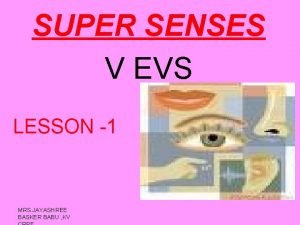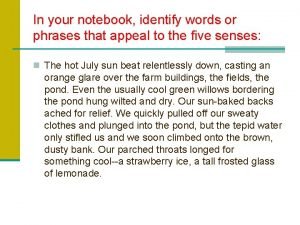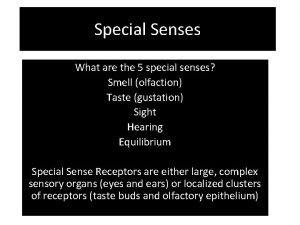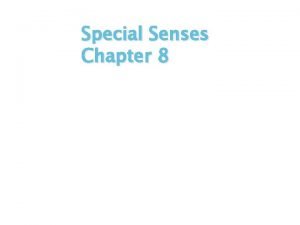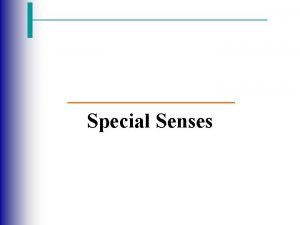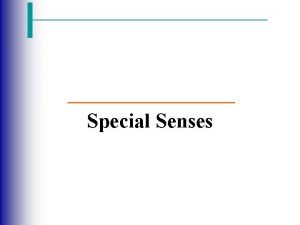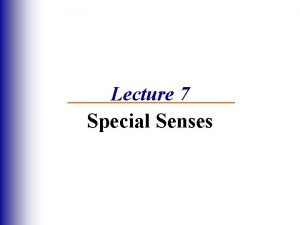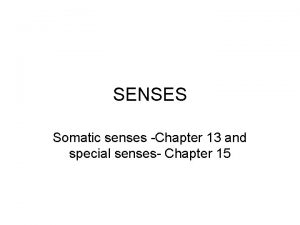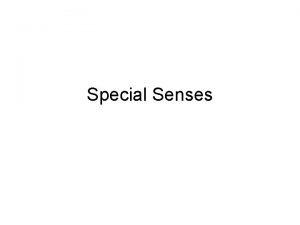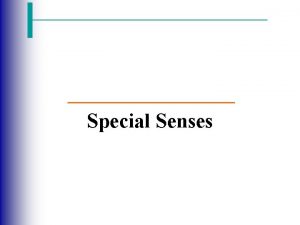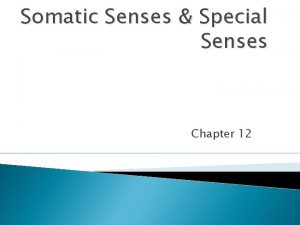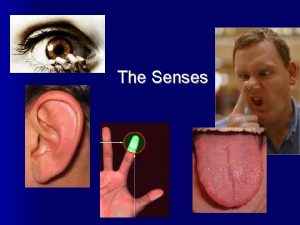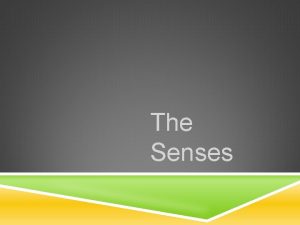The Five Senses What are the five senses















- Slides: 15

The Five Senses

What are the five senses? o What does a chocolate chip cookie taste like? o What does an ocean look like? o What does a skunk smell like? o What does a stuffed animal feel like? o What does a bell sound like?

What are the five senses? o Taste o Sight o Smell o Touch o Hearing

o Have you ever wondered why sometimes Taste you taste something and it can either taste really good or really bad? Your tongue and the roof of your mouth are covered with thousands of tiny taste buds. When you eat something, the saliva in your mouth helps break the food down. This provides your taste buds with a message to your brain telling you what flavors you are tasting. Taste buds are the largest part in helping you understand which foods you enjoy. Your taste buds can recognize four basic kinds of tastes: sweet, salty, sour, and bitter. The salty/sweet taste buds are located near the front of your tongue; the sour taste buds line the sides of your tongue; and the bitter taste buds are found at the very back of your tongue.

Taste Fun Facts: *We have almost 10, 000 taste buds in our mouths. *Insects have the most highly developed sense of taste. *Fish can taste with their fins and tail as well as their mouth. *In general, girls have more taste buds than boys. *Taste is the weakest of the five senses. o o Everyone has a different taste. In fact, your taste buds will even change as you get older. When you were a little baby, you had taste buds not only on your tongue but also on the sides and roof of your mouth. This means that you were very sensitive to foods when you were younger. As you grow, the those taste buds disappear leaving the majority on your tongue. As you get even older, you will most likely eat foods that you would’ve never touched when you were a kid! What if you couldn’t taste anything? Certain things including medications, smoking, not getting enough of the right vitamins, injury to the head, brain tumors, chemical exposure, and the effects of radiation cause taste disorders. More information on the sense of taste http: //users. rcn. com/jkimball. ma. ultranet/Biology. Pages/T/Taste. html

o Sight o Click below for a Diagram of the eye http: //www. kidshealth. org/kid /body/eye_SW. html From the moment you wake up to the time you go to sleep, your eyes are like a video camera. Everything you look at is sent to your brain for processing and storage. Sight is the most complex of the five senses. Pick an object in the room around you. Do you know how you can see it? You are actually seeing beams of light bouncing off the object and into your eyes. The light rays enter the eye through the cornea, which is a thick, transparent protective layer on the surface of your eye. The light then passes through the pupil (the dark circle in the center of your eye) and into the lens. If there is too much light, your pupil will shrink to limit the number of light rays that enter. Also if there is very little light available, the pupil will enlarge to let in as many light rays as it can. Just behind the pupil is the lens which focuses the image through the retina. The retina is filled with approximately 150 million lightsensitive cells called rods and cones. Rods identify shapes and work best in dim light. Cones on the other hand, identify color and work best in bright light. When these cells send the image to the brain, the image is upside down! The brain has the job of turning the image right side up and then to tell you what you are looking at.

Sight Fun Facts: *Most people blink every 2 -10 seconds. *Every time you blink, you shut your eyes for. 3 seconds, which means your eyes are closed at least 30 minutes a day just from blinking. *If you only had one eye, everything would appear two-dimensional. *Owls can see a mouse moving over 150 feet away with light no brighter than a candle. *The reason cat’s and dog’s eyes glow at night is because of silver mirrors in the back of their eyes called the tapetum. This makes it easier for them to see at night. *An ostrich has eyes that are two inches across. Each eye weights more than the brain. *A newborn baby sees the world upside down because it takes some time for the baby’s brain to learn to turn the picture right-side up. *One in every twelve males are color blind.

Smell The nose knows! Click below to see a diagram of the nose. http: //kidshealth. org/kid/body/nose_no. SW_p 2. html o What makes a smell is something that is too small to see with your eyeball alone. It’s even too small to be seen with a microscope! What you smell are tiny things called order particles. Millions of them are floating around waiting to be sniffed by your nose! Fun Facts: *Dogs have 1 million small cells per nostril and their small cells are 100 times larger than humans! *People who cannot smells have a condition called Anosmia. *If your nose is at its best, you can tell the difference between 4, 000 -10, 000 smells! *As you get older, your sense of smell gets worse. Children are more likely to have better sense of smell than their parents or grandparents.

Smell o Click below to visit a worksheet that can help you work on Good and Bad Smells http: //www. k 12. hi. us/~dechong/g oodbad. htm o You smell odors through your nose which is almost like a huge cave built to smell, moisten, and filter the air you breathe. As you breathe in, the air enters through your nostrils which contain tiny little hairs that filter all kinds of things trying to enter your nose, even BUGS! These little hairs are called cilia and you can pretend that they sweep all the dirt out of the nasal cavity, which is the big place the air passes through on it’s way to the lungs. After it passes through the nasal cavity, the air goes through a think layer of mucous to the olfactory bulb. The smells are then recognized because each smell molecule fits into a nerve cell like a lock and key. The cells then send signals along the olfactory nerve to the brain. Once they hit the brain, they are either read as those sweet smelling flowers or that stinky skunk. Soon your smell will connect with your memory. For example, the smell of popcorn may remind you of the movies or the smell of flowers may remind you of a favorite garden.

Touch http: //freda. auyeung. net/5 senses/touch. htm Click above to take a look at the touch sense. o The other four senses are located to a specific body part, but the sense of touch is found all over. This happens because touch originates in the bottom layer of your skin called the dermis. The dermis consists of many tiny nerve endings which provides information on what your body contacts. They do this by carrying the information to the spinal cord, which sends the message to the brain. The nerve endings can help you determine if something is hot or cold or even if something is hurting you. Your body has about twenty different types of nerve endings that send the messages to the brain. Pain receptors are the most important for your safety because they can protect you by warning your brain that your body is hurt!

o Touch Fun Facts: *You have more pain nerve endings than any other type. *The least sensitive part of your body is the middle of your back. *The most sensitive areas of your body are your hands, lips, face, neck, tongue, fingertips and feet. Some areas are more sensitive than others because they have more nerve endings. Have you ever bitten your tongue and wondered why it hurt SO bad? This happens because the sides of the tongue are very sensitive to pain, but not so sensitive to hot or cold. That is why it is so easy to burn your mouth! Try and stay away from HOT foods! Your fingertips are extremely sensitive also. Individuals that are blind read using Braille by feeling the patterns of raised dots on their paper. *Shivering is a way your body has of trying to get warmer. *There about 100 touch http: //www. k 12. hi. us/~dechong/hotandcold. htm receptors in each of your fingertips. Click above to do a worksheet on HOT AND COLD

Hearing Click below to visit the ear! http: //freda. auyeung. net/5 senses/hear. htm o Your ears serve as two very important purposes. Your ears help you to hear sounds as well as to help your balance. o When an object makes a noise, it sends vibrations into the air. They are then funneled into the ear canal. As the vibrations move inward, they hit your eardrum and cause that to vibrate as well. Once all of the vibrations go through to the nerve endings they hit the cilia. The cilia change the vibrations into messages that are sent to the brain through the auditory nerve. The auditory nerve carries the messages from 25, 000 receptors in your ear to your brain. Your brain then makes sense of the messages and tells you what sounds you are hearing.

Hearing o Many people have trouble hearing or cannot hear at all. These individuals have to highly rely on their other senses in order to function in the world around them. Fun Facts: http: //www. arches. uga. edu/~ andrea 1/sound. htm Click above to learn more about you hearing. *Babies can get earaches because of milk backing up, which causes bacteria to grow and may cause hearing problems later in life. *When you go up to high elevations, the change in pressure causes your ears to pop. *Children have more sensitive ears than adults. They can recognize a wider variety of noises. *Dolphins have the best sense of hearing among animals. They are able to hear 14 times better than humans. *Animals hear more sounds than humans. *An earache is caused by too much fluid putting pressure on your eardrums.

Closing More Fun Facts: *Many scientists say we actually have nine senses – sight, sound, taste, touch, smell, pain, balance, thirst, and hunger. *Hearing, sight, taste, touch, and smell are known as our external senses. *Pain, balance, thirst, and hunger are considered as our internal senses.

Closing o Our five senses are extremely vital to our wellbeing. We may be able to live without one or two, but we would have to adapt in order to use our other senses in a different manner.
 Antigentest åre
Antigentest åre 5 senses and 5 elements
5 senses and 5 elements Distinguish between general senses and special senses.
Distinguish between general senses and special senses. General senses vs special senses
General senses vs special senses Crocodile super senses
Crocodile super senses Five senses at the beach
Five senses at the beach In your notebook identify the function of each
In your notebook identify the function of each Descriptive essay beach using five senses
Descriptive essay beach using five senses 5 special senses
5 special senses Bio poem definition
Bio poem definition Five of five
Five of five Macbeth act five scene one
Macbeth act five scene one These beauteous forms
These beauteous forms ưu thế lai là gì
ưu thế lai là gì Thẻ vin
Thẻ vin Frameset trong html5
Frameset trong html5




